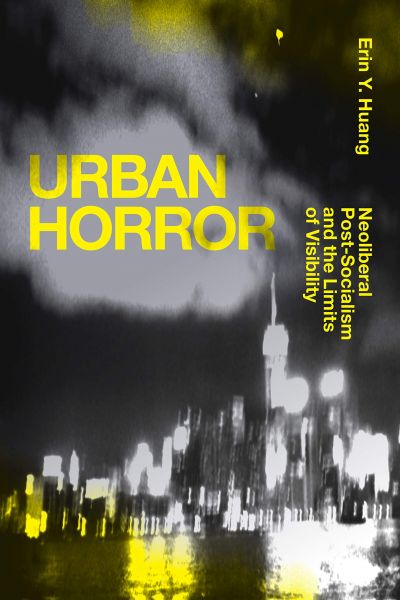
Urban Horror: A Conversation with Erin Y. Huang
As dystopic environments become reality, Erin Y. Huang’s Urban Horror: Neoliberal Post-Socialism and the Limits of Visibility (Duke University Press 2020) examines how cinema can help us comprehend the incomprehensible and navigate our own disorientation. For Huang, the scale, speed, and intensity of violence that circulates throughout the neoliberal world exceeds our frames of cognition and overwhelms our political vocabularies. The result is a diffuse sense of horror. The filmmakers from the Sinophone world that Huang engages—including Huang Weikai, Li Shaohong, Fruit Chan, and Tsai Ming-Liang among many others—are sensitive to the different sensory, affective, and political dimensions of what Huang calls ‘urban horror’, which no matter how bleak, also contains glimpses of alternative futurities.
Christian Sorace: In the introduction, you define horror as a ‘historical mode of perception arising when the perceived external reality exceeds one’s internal frame of comprehension’. Can you give an example for our readers to explain why this gap can be so horrifying?
Erin Huang: We live in a world of horrors, where the techniques and technologies of war and extraction continue to evolve and devastate. The present era, which I explore as the emergence of the post-X era, wherein the present can only be understood through the hyphenated and residual relationship with capitalism and socialism, has seen the unimaginable expansion of atrocities, humanitarian crises, economic extractions, and environmental degradations, in an expanding list that continues to grow each day. And as an accompanying phenomenon, we have never been more exposed, in an intimate fashion, to the images, sounds, and sensory transmissions of violence, whether distant or near, in the saturated media environment that now structures our everyday life. Therefore, the question that confronts us in the era of hypermediatised horror is never the lack of adequate examples of catastrophe, but the overabundance of images that overwhelms and paralyses feelings and actions, fatiguing rather than accelerating the reimagination of shared common wealth.
For this reason, in a counterintuitive way, the horror that permeates art and cinematic productions of the post–Cold War Sinophone Asia is not the appearance of new (Asian) monsters, serial killers, or ghosts, belonging to the genre of commodified horror in existing Western literary and film conventions. Rather, the horror addressed in this book speaks to a paradox of vision, where body-centred horror that mirrors a specific mode of representing capitalism in its early stage—for example, in the aesthetic genres of vampires and zombies—can no longer speak to the disappearance of an identifiable agent of horror in the neoliberalising world. In fact, it is precisely the visible that has become the incomprehensible. For example, when filmmaker Chan Tze-woon moves his camera in Yellowing, which documents the 2014 Umbrella Movement in Hong Kong, the camera’s gaze wavers between the firework show in the sky celebrating China’s National Day, and the police teargassing demonstrators on the ground. The sounds and smoke of explosion from above and below become contiguous, proposing a deterritorialised post-socialist reality that is hypervisible, but for which no adequate frame of comprehension exists. The affect lingers, suggesting a mixture of emotions that persist and are recorded as excesses that do not dissipate. They open up, rather than closing down, a new path of affective communication and connection. This horror is frightful and evokes the sentiment of resistance, but it is representative of a newly emergent feeling belonging to the era the book examines. Tracing the dissemination of a Marxian horror in the post-socialist and post-capitalist world, the ‘horror’ in the book tells the affective history of transterritorial neoliberal capitalism that grows and transforms along with the geopolitics of post–Cold War global economy.
CS: You have some beautiful passages in the book devoted to the ‘future of the image’ and the ‘history of affective rehearsals of revolutions that cannot otherwise be told’. Can you elaborate on the revolutionary potentiality of cinema?
EH: The future of the image is a question that French philosopher Jacques Rancière asks. Reflecting on scholarly discourses of the ‘image’, often treated as the passive site of inscription, fetishism, and commodification, Rancière’s question arrives at the moment when the image has become the ubiquitous basis of our understanding of reality. Yet the relationship between image and reality has still not been solved, regardless of the image’s transition of medium specificity from literature to painting, photography, film, and computer software. This is an intriguing question for me to consider, writing a book that covers the media landscape from the 1990s onward when the image is said to have lost its transformative power due to market commodification and deepening self and political censorship under the neoliberal post-socialist regime.
When the expression of public dissent becomes increasingly difficult, and when the image seems to have lost meaning, the film texts collected in this book suggest a fundamental rethinking about the post–Cold War media environment and the power of the image. For readers who are searching for the familiar tropes of ghosts, monsters, and spectres that are representative of the return of the repressed—the resurgence of past traumas and violence that continue to haunt the present—the urban horrors presented in this book frustrate expectations, yet for a specific reason. Different from the Freudian theorisation of repressions and returns that provides an account of the psychological mechanisms of memories and symptoms, urban horror is derived from Friedrich Engels’s industrial horror, where the sentiment of horror is evoked in correspondence to an anticipated future and the possibility of an aggravated calamity. The emphasis is on the speculation of the future that is reshaping the legibility of the present. Produced during the decades after the demands for democracy were foreclosed in post–Cold War China, the films in this book collectively rehearse different realities, setting in motion the potentialities of a different future, every time an additional viewer encounters the image.
CS: Since the publication of your book, it would seem that we are even more enveloped in the logic of urban horror. Would you recommend any films that help us reflect on the current pandemic as a form of urban horror?
EH: This pandemic has made visible the systematic management of not life, but death across specific racial, minoritised, and vulnerable groups. This phenomenon not only exists in the United States but is a part of an expanding global circuit of neoliberal economic practice that is built on the foundations of old and new colonial relations. One specific practice we can consider here is the world’s dependence on the post-socialist Chinese Special Economic Zones (SEZs) that fuel the global economy through state-managed supply of low-cost labour. For several decades since the Chinese state’s experiment with SEZs—exception zones that allow for the state’s strategic participation in the global economy without disrupting its political regime—the growth of Chinese SEZs has transformed the relationship between East and West, and socialism and capitalism. As the trade war between the United States and China intensifies, the pandemic spotlights the transcontinental global logistics chain that stretches the conventional factory to different parts of the world and makes visible newly emergent neoliberal spaces that rarely draw public attention. These include container ports, special economic zones, transit and processing centres, and logistics cities—all of them spaces that accelerate the spread of the virus. These logistical spaces constitute the transmission routes of Covid-19, proposing a different world map created under the neoliberal post-socialist condition. A recent cultural text that comes to mind is actually not a film but a novel, Ling Ma’s Severance—reviewed by Ivan Franceschini in this issue of the Made in China Journal—that details post-apocalyptic New York, destroyed by a virus that spreads from Shenzhen Special Economic Zone and the neoliberal trade routes to the entire world. Written shortly before the current pandemic, the novel is already rehearsing the discomforts, anxieties, and soft critiques of racial injustices of offshore Chinese labour from the perspective of a Chinese American writer. There are a few films from my book where a virus setting opens up an affective landscape of resistance addressing necropolitical economic precarity and encroaching colonialism. For example, Tsai Ming-liang’s The Hole (1998), and Fruit Chan’s The Midnight After (2014).
CS: We would love to have a preview of your new research on the ‘visual mapping and infrastructural development of oceanic urbanisation’. What is catching your eye here?
EH: The ocean is the forgotten space. ‘Out of sight, out of mind’, as maritime photographer and filmmaker Allan Sekula said. Yet despite the common belief that we have entered the age of instant telecommunication and transaction, the ocean continues to be the material basis of global capitalism. As container ships slowly but persistently travel across oceans and continents, the growing demand for mega-ships, deep water ports, artificial islands, inland highways, and train tracks is illustrative of an infrastructural revolution reconfiguring the relationship between land and sea, continental and oceanic empires, and for my specific interest, the expansion of Sinocentric neoliberal post-socialism beyond socialist China that is affecting the entire world. One can immediately think of China’s recent Belt and Road Initiative (BRI) that dreams of the revitalisation of the land and maritime Silk Road in the twenty-first century. Reconfiguring the infrastructural connections between Asia and Europe while transforming the South China Sea into a militarised transit ocean between East and West, the BRI has generated abundant study of the economic, political, and environmental impacts and the future of infrastructure. Yet for my interest, the BRI is one of the most visible media events in the past decade, generating state-sponsored YouTube channels, documentaries, science films, and satellite photography that have not been carefully considered.
Often characterised as free, open, and expansive, the ocean plays an important role in the discourse and imagination of oceanic neoliberalism and requires a new theory of contemporary oceanic imperialism. Racialised, gendered, and fraught with conflicting territorial claims, the ocean is generative of romantic associations with freedom although it in reality occupies the primary locus of international conflict, militarisation, and labour exploitation. I am curious to see how to propose an ocean-based and archipelagically expanding theory of critique that revises the land-based concept of capitalism. Starting with the artificial desert islands in the South China Sea, where European, Japanese, Chinese, and Southeast Asian (neo)colonial histories collide, I hope to reimagine and uncover an oceanic Asia that is the site of violence, remembered and re-envisioned by a growing number of thinkers concerned with economic, indigenous, feminist, and environmental justice.





